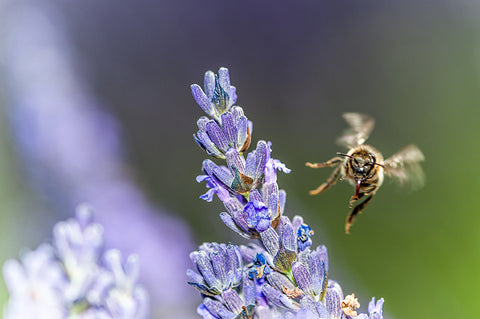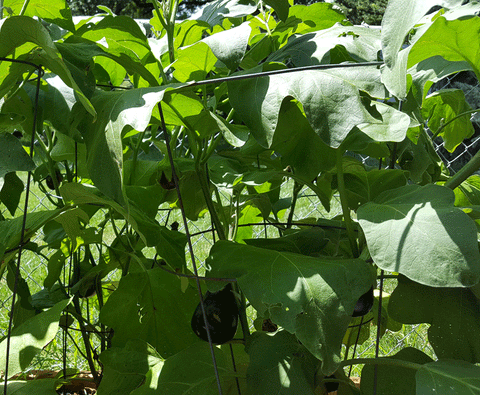100% pure Lavender, Spike essential oil

Spike Lavender (Lavandula latifolia)
Family - Lamiaceae
Country of Origin – Spain
Steam distilled from organic flowering tops
So many lavenders to choose from. This one in particular is distinctly different than the varieties of Lavandula angustifolia, commonly called True Lavender. Spike Lavender is definitely a "lavender" but from a different variety.
- Contains considerably more camphor and 1,8-cineole which increases its medicinal value, but decreases the relaxing properties.
- Scent is less sweet and flowery and more camphorous
- Often used for medicinal purposes such as relieving painful cuts and scrapes
- Useful in cold and flu blends and respiratory issues but more gently than oils with higher cineole content.
- Can be useful for mental stimulation and increasing alertness
- Useful for muscular aches and pains or injuries
- Has been reported to be useful for migraines. I personally use our Bulgarian Lavender, but haven't really tried the Spike Lavender and it would depend on what is causing the migraine
- Skin issues such as pimples and rashes
- Relieves insect bites
- Well known antibacterial and antifungal properties, with some antiviral properties
- Can be helpful for stimulating the immune system
As you can see, Spike Lavender is not as expensive as our Bulgarian Lavender. This is true because when distilled, this plant produces almost three times as much essential oil as "True Lavender" and is, therefore, sometimes used to adulterate True Lavender. Another good reason to know how to read your GC/MS reports. Spike Lavender is also grown at lower altitudes and makes for easier farming and, as per Salvatore Battaglia, loves growing by the sea. Lavandin and Spike Lavender are often passed off to other industries such as soapmaking and perfumery to be used as "lavender".
The scent? I personally love this lavender because I know not to expect the flowery smell of the true lavender (which I do very much love - it's just different). You will notice the more medicinal, but not unpleasant, scent of this oil. It's bright and clean and fresh, but still smells like lavender. Which is why I like to use it in respiratory blends, muscle relief blends or antiseptic type blends.
Andrea Butje in her excellent book "The Heart of Aromatherapy" suggests that Spike Lavender could and should be used prior to a workout to help stimulate the circulation and prevent cramps. Also this is helpful for muscle pains when you still want to be alert and not in a more sedated condition that Lavandula angustifolia would cause. I love this that she wrote - "Spike Lavender has the same comforting, nurturing personality (as true lavender), but with a 'kick' that encourages you to get back out there and keep going. It loves giving pregame pep talks to make you feel empowered and congratulating you so you keep feeling good after you're done playing." I love the way she has written this book - please do yourself a favor and pick up a copy.
Below is a fairly recent GC/MS of Spike Lavender from Spain and is fairly representative of what you should expect. France and Italy are also countries that grow and distill this essential oil.
|
GC/MS of Spike Lavender (Lavandula latifolia)
|
USAGE AND SAFETY: Please, please, please do not drink essential oils. Do not put this essential oil in your water and use it ONLY diluted (see our dilution chart) for your specific purpose. This particular batch of lavender is from Spain, but it is not "Spanish Lavender", which usually has a higher camphor content and it's botanical name is Lavandula stoechas. Robert Tisserand says that Spike and Spanish Lavenders may be "mildly neurotoxic" due to their camphor content. However, because of its percentage of linalool, it may, as Robert Tisserand says, "mitigate the neurotoxicity of camphor" that exists in Spike Lavender. The camphor also, however, makes it useful for colds and respiratory issues, as well as aching muscles. The GC/MS on this batch of Spike Lavender has camphor as only 12%. Due to the relatively high content of linalool, this oil can possibly become oxidized, so keep in a cool, dark place and keep the dropper safety cap on when not in use. The oil when undiluted (don't do it!) can be irritating. Some of this can occur when an essential oil is not properly stored. Not hazardous during pregnancy UNLESS the camphor content is high - again check out your GC/MS prior to purchasing.
Useful in daytime blends and use cautiously in children under 10, just being sure to adequately dilute the essential oil.
Rosemary's Easy Focus Headache Inhaler (from Andrea Butje's book, page 213)
9 drops rosemary ct camphor
3 drops spike lavender
3 drops basil ct linalool
For children:
4 drops orange
1 drop lavender (assuming she means Spike Lavender?)
1 drop basil ct. linalool
This in my opinion is just one of the most underused, under-appreciated essential oils available and for a reasonable price it can be substituted for its more expensive cousin Lavandula angustifolia if you compare the different uses for each oil; i.e., one is a relaxant/sedative and the other (Spike) can be a stimulant.
Due to my hopes and dreams of some day growing and distilling, this plant is also a very good attractant for bees and butterflies. Do you want to grow your own? Here is some information about that. This variety can handle transplanting and requires full sun exposure. According to garden.org, plant lavender seeds beginning in summer and through the fall months. "They are slow to germinate, lavender seeds require patience. It will take about eight weeks for the seeds to develop enough to transplant to their final location."
Thanks for listening!

Ann
Find out more about me and Wingsets by clicking Our Story.
Ann's mission statement is to provide health and wellness information to you and your family that you may not find in your every-day newspapers or Prevention magazines. Her college studies, certifications and passionate self-study have provided her with a huge spectrum of understanding of the intricate issues and debates concerning health, nutrition herbalism and skin care. Ann was a Critical Care Registered Nurse, is a Certified Clinical Aromatherapy Professional, and has been studying nutrition, aromatherapy, skin care health and medicinal herbalism for at least 15 years. Not so surprisingly, all of these interact for health and wellness at a level we all want to achieve. She is an ardent pursuer of verified research and information and spends huge amounts of time searching for information that is relevant and evidence based. We sincerely hope you benefit from her efforts.
See our disclaimer statements here.

































